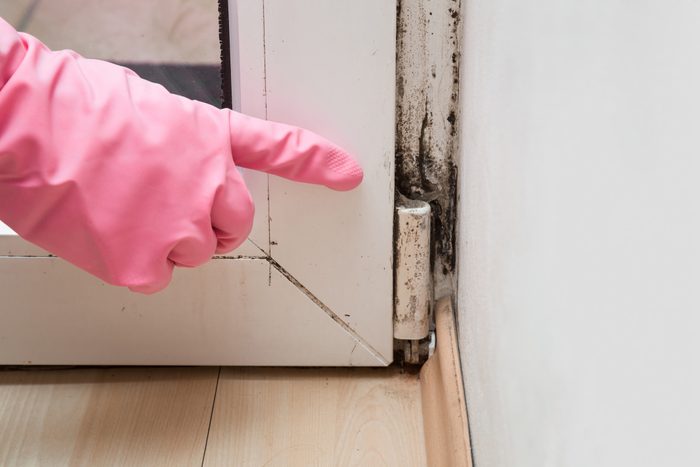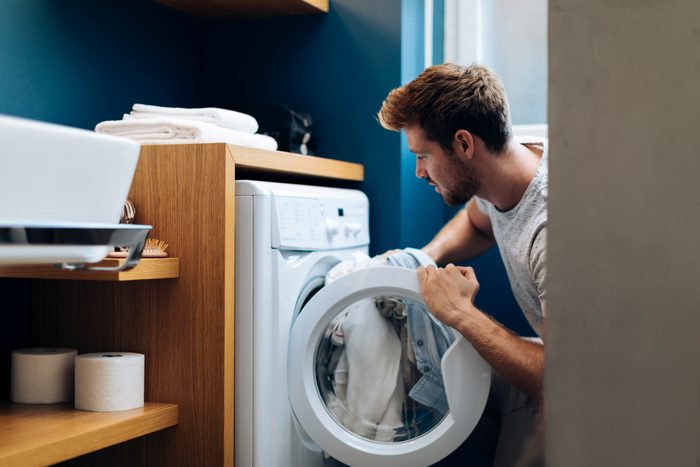
Aside from some cheesy exceptions, when you find food in your fridge sporting the tell-tale sign of mold—a green, white, or black fuzz—it should get an express ticket into the trash. At best, moldy food is a sign of spoilage, so it won’t taste great. But, it could also be dangerous to consume. “There are over 100,000 species of mold identified so far,” explains Michael Rubino, a mold remediator, air quality expert and the author of The Mold Medic: An Expert’s Guide to Mold Removal. While many of these species might be harmless, the United States Department of Agriculture points out that some mold can be toxic, which means the health effects of mold can be serious.
Your fridge also isn’t the only source of potentially problematic mold. In fact, the Centers for Disease Control and Prevention (CDC) says that mold is present in most—if not all—US households. Says Kelly Johnson-Arbor, MD, a medical toxicologist and co-medical director a the National Capital Poison Center: “Mold spores are tiny, which allows them to float easily in the air and remain invisible to the human eye.” Dr. Johnson-Arbor adds: “Since they’re present in the air we breathe every day, it’s quite difficult to keep a home completely free of mold.”
Can UV air purifiers help manage mold? Experts explain how this light-based tech works

Where does mold grow in the home?
Mold can grow in as little as 24 to 48 hours, provided there are sources of food and moisture, Rubino says. “Given the estimate that at least 50% of US households have current or previous water damage, it’s safe to say this is an increasingly common problem.” And if a household isn’t taking preventive measures to reduce moisture opportunities, there’s a greater chance of mold growing and multiplying.
With years of environmental exposure, aging materials and poor ventilation, older homes are often susceptible to mold accumulation. But “current building practices are also an issue,” Rubino says. “The standards now are pushing for net-zero energy efficiency, which means that there’s very little airflow between the indoor and outdoor environments.”
Fix poor airflow in your home with these expert-recommended air purifiers for mold
Areas in the home with high levels of moisture or that are rarely frequented should be at the top of the list of places homeowners should regularly inspect, he explains. “These are also the areas where preventative measures should be a focal point, such as deep cleaning, humidity management, and air filtration.”
Common hotspots for mold include:
-
Attics, basements and crawl spaces
-
Toilet tanks, washing machines, grout and caulk
-
Windowsills and door frames
-
Underneath sinks
-
In carpeting
“Mold can even grow in items that we use to eat or drink from, like water bottles and coffee makers, since these also contain moisture,” Dr. Johnson-Arbor adds.
Get The Healthy @Reader’s Digest newsletter for daily health and wellness advice straight from the experts

What are the health effects of mold?
“In short, the answer is: it depends,” Rubino explains.
This is because many factors contribute to someone’s reaction to mold, including their genetics, the volume and length of mold exposure and the status of someone’s immune system. “Any mold growth in a home has the potential to trigger adverse health reactions in individuals, but it varies per person.” One person may experience an occasional headache, while another may develop more than a dozen symptoms.
Those with a developing or compromised immune system are often at a greater risk for serious health effects of mold. In addition, those with a mold sensitivity or allergy, and people with asthma, may experience more intense reactions, according to the CDC.
Are you sure mold is causing your symptoms? Learn more about these 8 other common indoor allergens
As with mold growing on food, the type of mold growing in your home matters as well. “Not all mold is bad,” Dr. Johnson-Arbor says, while some species are more problematic to our health. She points to a mold called Mucorales, a species that grows in soil, bread, and dust. “Inhalation of [Mucorales] spores, consumption of contaminated food, or skin contact can cause serious and sometimes fatal fungal infections.”
Rubino adds that other types of mold produce a toxic byproduct called mycotoxins. Research shows that certain mycotoxins—like aflatoxin and ochratoxin—can contribute to a range of adverse health effects, including kidney damage, liver damage, immune system suppression, cancer and birth defects. “The impact of other mycotoxins in human health is not completely understood, but it’s possible that they may play a role in the development or progression of inflammation, gastrointestinal disease, and other medical conditions,” Dr. Johnson-Arbor says.
On the flip-side, inhaling “the mold Stachybotrys chartarum—or ‘black mold’—was once believed to cause serious medical conditions, including pulmonary hemorrhage,” Dr. Johnson-Arbor says. But there is currently no conclusive link between this mold and disease.
Rubino explains: “Much more research is needed to determine exactly how exposure to indoor mold growth affects the body” because everyone reacts differently. But he says that studies are beginning to link some autoimmune conditions to mold exposure, such as Mast Cell Activation Syndrome, Chronic Fatigue Syndrome, and Chronic Inflammatory Response Syndrome. It’s also well-established that mold exposure can worsen asthma and trigger attacks, but another recent study by UC Berkeley School of Public Health researchers finds that childhood exposure to household mold can increase the risk of developing the chronic lung disease.

What are the symptoms of mold exposure?
Again, the health effects of mold can be different for everyone. But in general, Rubino says that if you’re experiencing some combination of these common symptoms, there could be a mold problem in your home:
-
Headaches and migraines
-
Allergy symptoms and persistent colds
-
Chronic fatigue and decreased physical mobility
-
Hives, eczema and skin rashes
-
Brain fog, cognitive difficulty and other neurological issues
-
Hormone disruption and infertility

Can I test myself for mold exposure?
There are tests available (in a doctor’s office) to check for a suspected mold allergy or sensitivity, but no accurate diagnosis method exists to test your physical level of mold exposure. Some labs offer blood or urine-based tests such as a “mycotoxin blood test,” but these are not approved by the US Food and Drug Administration (FDA), and the CDC discourages their use.
Home mold testing is also available, but “it’s important to remember that there are no federal standards for mold or mold spores,” Dr. Johnson-Arbor says. “Because of this, home mold testing doesn’t really provide much information about the severity of a mold exposure or whether the presence of a certain amount of mold is associated with certain unwanted health effects.”
That’s why generally, the best way to avoid potentially harmful mold is to remove whatever’s present and prevent it from growing again. And here’s how experts say you can start getting rid of mold growth in your home.
Follow the Healthy on Facebook, Instagram, and Twitter. Live better—keep reading:
